Chickens come in different sizes and shapes, as well as temperaments. They also have different purposes, including egg production, meat production, and for poultry shows.
If you plan to raise chickens, you are likely to be tempted to prefer the larger breeds over the smaller ones. If you already have chickens, larger breeds can also be an ideal addition.
Jersey Giant is so far the biggest chicken breed of all. This American breed is a dual-purpose bird, which means they are great egg layers and meat producers. It is also one of the tallest chicken breeds in the world. The second largest chicken breed is the Brahma, which is dubbed the “King of Chickens.”
Size matters, as they say. This famous quote can also be applied when it comes to raising chickens. But before you choose, you should know them better, so you will learn how to treat them properly.
This comprehensive guide explains everything about the 14 largest chicken breeds, their purpose, and some useful tips on how to care for them.
14 Largest Chicken Breeds
1. Jersey Giant
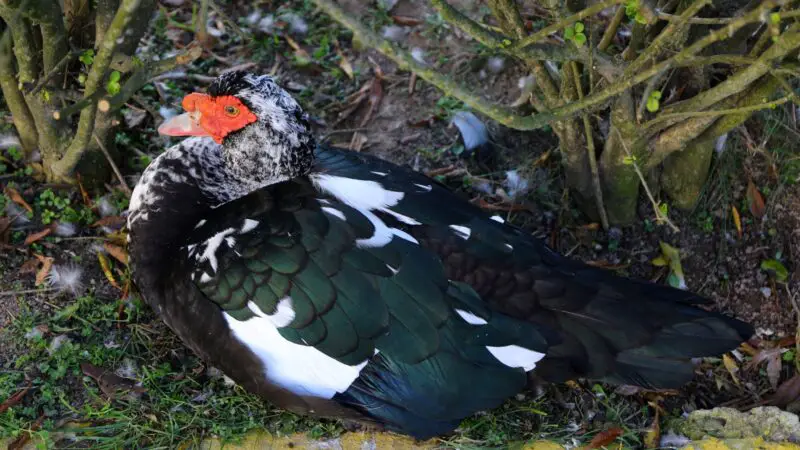
Place of Origin
As the name suggests, the Jersey Giant originated in New Jersey, USA, in Burlington County. This breed was created by the Black brothers, John and Thomas between 1870 and 1890.
It was developed using Black Javas, Black Langshans, and Dark Brahmas. At that time, the plan was to find a replacement for turkeys as the common table bird.
Appearance
Without a doubt, the Jersey Giant is the largest chicken breed in the entire world. Aside from having a gigantic body frame, they have dark brown eyes, single red combs, red wattles, featherless legs, and relatively short tails.
Their bodies are long and deep, and their backs are broad and flat. This appearance makes them look like a square birds.
Color
Jersey Giant chickens have three different color variants – black, white, and blue. The Black Jersey Giant was admitted to the American Poultry Association (APA) Standard of Perfection in 1922, followed by the white in 1947 and the blue in 2003. Other color varieties that are not recognized by the APA are Barred, Splash, and Silver.
The black variety has a stunning “beetle green” sheen, black legs, and yellow soles. The White Jersey Giant chicken has a more-yellowish beak, willow-colored legs, and yellow soles.
Meanwhile, Blue Jersey Giants have slate-blue feathers with darker blue lacing, while shanks are black or dark willow. All of them have four toes on each foot.
Height
Jersey Giant roosters can grow between 22 and 26 inches (55.8 and 66 cm) tall, while hens can be 16-20 inches (40-50.8 cm) tall. This makes them one of the tallest chicken breeds in the world.
Weight
Jersey Giants are also among the heaviest chicken breeds in the world. Roosters weigh about 13-15 lbs (5.9-6.8 kilos), while hens have an average weight of 11 lbs (5 kilos).
Bantam males can weigh around 38 oz (1.1 kg), and bantam females can reach up to 34 oz (0.96 kg).
Wingspan
There are no records showing the wingspan of Jersey Giant chickens.
Lifespan
Jersey Giant chickens can live between 6 and 8 years and a bit more.
Characteristics
Jersey Giant chickens are docile and friendly to humans, including small children. They love to be cuddled and are also tolerant of other chicken breeds. Their calm nature allows them to live peacefully in a mixed flock.
They are also great foragers, but their huge bodies prevent them from flying high. These affectionate birds are also very cold and hardy.
Purpose
Jersey Giant chickens are a dual-purpose breed but are more efficient in producing meat than in laying eggs. Hens lay 160- 200 extra-large brown eggs a year, which can equate to 3-4 eggs a week.
They can also lay eggs during winter. On the other hand, these gentle giants grow very quickly and can be butchered at 8-10 months old only.
2. Brahma
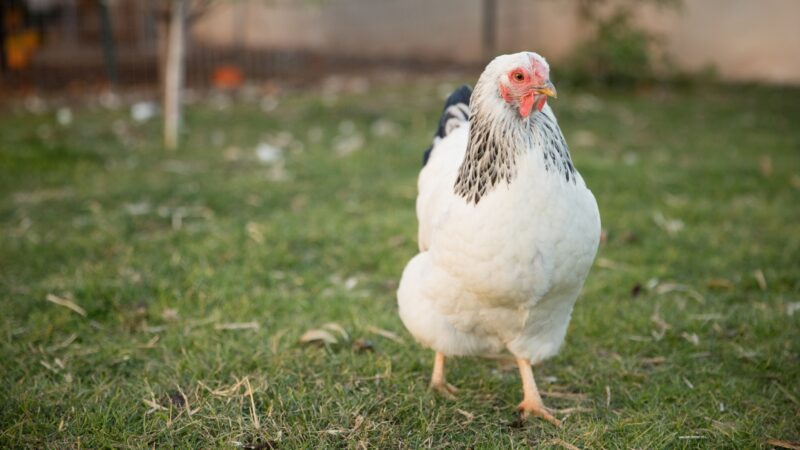
Place of Origin
The Brahma chicken is an American breed that was imported from China sometime in the 1840s. It first arrived in Europe in December 1852, when breeder George Burnham gave nine of them to Queen Victoria of England as a gift.
However, it was named after the Brahmaputra River in India and was shortened to “Brahma” in 1853 by T.B. Miner.
Appearance
The Brahma chicken is a very beautiful bird. This chicken breed has reddish-brown eyes, a pea comb, red earlobes, a yellow beak, a broad head with projecting eyebrows (called “beetle brow”), and feathers on its shanks and toes. Brahma chickens also have thick feathers, and their bodies look like a V-shape when you view them from the side.
Color
The Brahma chicken has three different color varieties – Buff, Dark, and Light. All of them are recognized by the American Standard of Perfection.
The bantam versions have two additional color varieties – Black and White. Both of them are rare, though. Interestingly, each color variety is very different from the others and can easily be identified.
Buff Brahma chickens have the same color patterns for black and white, except that the base is golden buff instead of white. Dark Brahma roosters have silver hackles and saddle feathers, while hens have black hackles with slight gray penciling. Meanwhile, the feathers and hackle of light Brahma chickens have black stripes and white edges.
Height
Brahma chickens can grow up to 30 inches (2.5 feet) tall. In March 2017, a viral video showed an extremely huge Brahma rooster named “Merakli.”
The giant chicken can be seen getting out of his coop in Kosovo and reportedly stands 3 feet tall! Some people thought the video was fake, but the Livestock Conservancy confirmed that it was real.
Weight
Brahma chickens are a very heavy breed. In 1901, Brahma roosters weighed about 17-18.25 lbs (7.7-8.28 kilos), and hens weighed around 13-14 lbs (5.9-6.4 kilos).
Today, male Brahma chickens have an average weight of 12 lbs (5.4 kilos), and females have an average weight of 10 lbs (4.5 kilos). Merakli the Brahma chicken weighs 7.7 kilos.
Wingspan
Referred to as the “King of All Poultry,” Brahma chickens have an average wingspan of 37-42 cm (14.5-16.5 inches).
Lifespan
Brahma chickens can live between 5 and 8 years, which is also the same lifespan as most chicken breeds. If properly taken care of, some of them can live a bit longer. But because of their enormous size, they should have regular exercise to avoid obesity.
Characteristics
Despite being one of the largest chicken breeds in the world, Brahma chickens are very friendly and docile. They are very easy to handle and can tolerate both free range and confinement.
These gigantic birds are also very cold, hardy, friendly to other breeds, and unlikely to be attacked by predators. As expected, Brahma chickens cannot fly well.
Purpose
Brahma chickens are a multi-purpose breed and are great in meat production and as show birds. They usually reach their full weight in their 1st year, and their meat market weight is 8-10 lbs.
Hens are considered good egg layers, laying 150-200 eggs a year or 3-4 eggs a week. They can start laying eggs at 6-7 months old and tend to go broody.
Related: Brahma Chicken | Information and Facts!
3. Buff Orpington
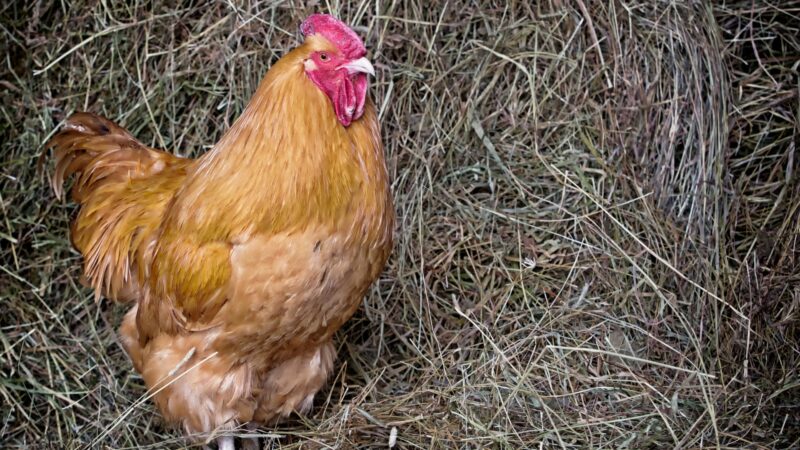
Place of Origin
The Orpington chicken was developed by William Cook of Orpington, England in 1886. The Black Orpington is the original color variety, followed by the Buff variety, which is also very popular.
The Buff Orpington is a cross between Buff Cochins, Dark Dorkings, and.Golden Spangled Hamburgs. Orpington chickens arrived in the US in 1891.
Appearance
Buff Orpingtons have pinkish-white beaks, broad bodies, curvy, short backs, and very fluffy feathers. Their medium-sized single combs, earlobes, eyes, and wattles are all red.
Their legs and feet are short, pinkish-white, and have no feathers. When viewed from the side, their bodies form an elegant U-shape, which is more obvious in roosters.
Color
As their name suggests, Buff Orpingtons are light brownish yellow or rich gold. It was admitted to the American Standard of Perfection in 1902. Other color varieties of the Orpington chicken are black, white, and blue. All of them are also recognized by the APA.
Height
All color varieties of Orpington chickens are relatively tall, having an average height of 1 foot. Roosters stand between 12 and 15 inches tall, while hens are slightly shorter.
Weight
Orpington chickens are considered a heavy breed. Roosters can weigh 8-10 lbs (3.6-4.5 kilos), while hens weigh around 6-8 lbs (2.7-3.6 kilos). Bantam males have an average weight of 38 oz (1 kilo), while bantam females are around 34 oz (0.96 kilos).
Wingspan
There are no records about the wingspan of Orpington chickens.
Lifespan
Buff Orpington chickens can live between 8 and 10 years. Other color varieties have the same average lifespan.
Characteristics
Like other color varieties, Buff Orpingtons are naturally calm, friendly, and love being cuddled. Despite their enormous size, they are not aggressive toward humans and other breeds.
Overall, they are also fairly quiet. Orpington chickens are very cold and hardy as long as they are dry. Amazingly, they can also tolerate the average heat of summer.
Purpose
Orpington chickens were originally bred for dual purposes, and they still are. Hens are capable of laying 200-280 large brown eggs a year, which is around 4-5 eggs a week.
This chicken breed grows fast and can already be sold for meat once they are 5-6 months old. Their market meat weight is between 7.0 and 8.5 lbs (3.17 and 8.5 kilos).
4. Dong Tao
Place of Origin
As the name implies, the Dong Tao chicken originated in Dong Tao, a village in Khoai Chau District, Vietnam. Also called Dragon Chickens, this Vietnamese chicken breed used to be served as a delicacy offering to the kings and mandarins. Nonetheless, Dong Tao chickens are locally rare and are almost not available outside the country.
Appearance
Dong Tao chickens look like dragons since they have very thick and strangely-scaled legs and feet, which also appear to be deformed.
This unique and odd-looking chicken breed has a big head, wicked eyes, a huge, red comb and wattles, and a short, curved beak. They have huge and wide bodies, making them difficult to carry using one hand.
Color
Dong Tao roosters are a mixture of red, black, gray, red, and white, while hens are usually white or white with light brown. There are no other color variations, though.
And because they are a very rare breed, Dong Tao chickens have not yet been admitted to the American Standard of Perfection.
Height
The enlarged legs of Dong Tao chickens alone can be as long as a wine bottle, making them one of the tallest chicken breeds in the world.
Weight
Dong Tao chickens are a very heavy breed. Males can weigh up to 13 lbs (6 kilos), while females weigh about 10 lbs (4.5 kilos). Yet, these rare chickens are slow growers and it takes 8 months to 1 year before they reach their adult weight.
Wingspan
There are no records showing the wingspan of Dong Tao chickens.
Lifespan
If raised properly, Dong Tao chickens can live between 6 and 7 years. But because of their enormous legs, breeders need a lot of time and patience in keeping them healthy.
Characteristics
Despite their dragon-like legs, Dong Tao chickens are generally friendly and docile. They are also not known for being aggressive towards other breeds.
But as expected, their fragile legs make them very sensitive during winter and to the changing weather. This unique chicken breed flies occasionally and requires lots of space for exercise.
Purpose
Dong Tao hens are very poor egg layers, laying only 62-83 eggs per year, or 1 egg a week. With their huge legs, they tend to accidentally kill their eggs.
Interestingly, they take part in a beauty contest every Lunar Year in Vietnam. But more importantly, Dong Tao chickens are bred for meat production, and their meat is a very expensive cuisine.
5. Cochin
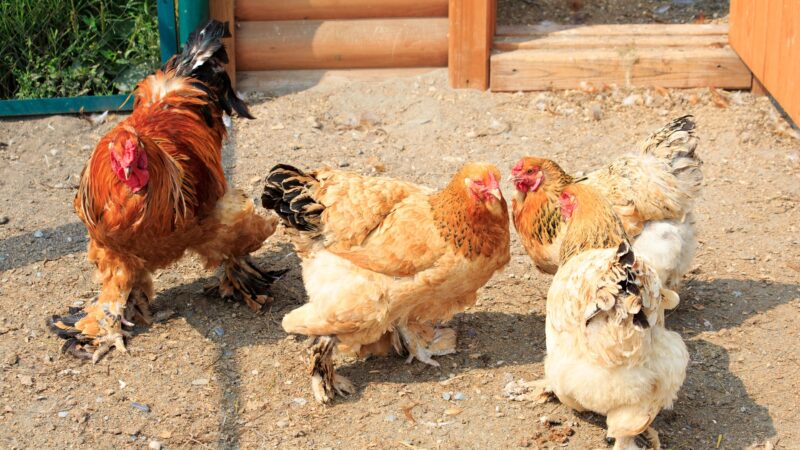
Place of Origin
Cochin chickens were developed in Shantung Province, China, and were then called “Ju-chin,” which means “nine picules.” One picule is equivalent to 11/4 lbs.
Also once called Shanghai chicken and then Cochins-China, this breed was once a gift to Queen Victoria of England and was exported to England and the US during the mid-1840s.
Appearance
Aside from having large and round bodies, Cochin chickens have fluffy feathers all over their bodies up to their legs. Their skin is yellow, and their bodies form a heart shape when viewed from the side.
Their single combs, wattles, and earlobes are all red. As expected, Roosters have longer wattles and bigger combs compared to hens.
Color
The Cochin chicken comes in various colors and patterns, which are all admitted to the APA or the American Bantam Association (ABA).
This includes Barred, Birchen, Black, Black-tailed Red, Blue, Brown, Brown Red, Buff, Buff Columbian, Columbian, Golden Laced, Lemon Blue, Mottled, Partridge, Red, Silver Laced, Silver Penciled, and White.
Height
Cochin chickens are considered a giant breed and are very tall. Cochin roosters can grow up to 21 inches tall, while hens have an average height of 15-16 inches.
Weight
Cochin chickens are not only huge; they are also among the heaviest chicken breeds in the world. Cochin roosters can weigh a whopping 11 lbs (5 kilos), and hens have an average weight of 8.5 lbs (3.8 kilos). Bantam roosters weigh about 900 grams (31.7 oz), and bantam hens are about 800 grams (28.2 oz).
Wingspan
There are no records showing the average wingspan of Cochin chickens.
Lifespan
Cochin chickens are very healthy birds and have long lifespans. In fact, they can live between 8 and 10 years.
Characteristics
Cochin chickens are exceptionally gentle and have a calm disposition. They are among the friendliest chicken breeds and love being cuddled by small children.
Some roosters can be aggressive but in very rare moments. Both sexes are not bullies and are quiet in general. They don’t do well in the heat but are also among the most cold-hardy breeds.
Purpose
Cochin chickens were originally bred as show birds, but they were later discovered to be useful in egg and meat production. Hens lay around 150-200 medium to large brown eggs a year and are very broody.
This heavy breed also produces a good amount of breast meat. But because Cochins mature slowly, they are seldom used as meat birds.
6. Plymouth Rock
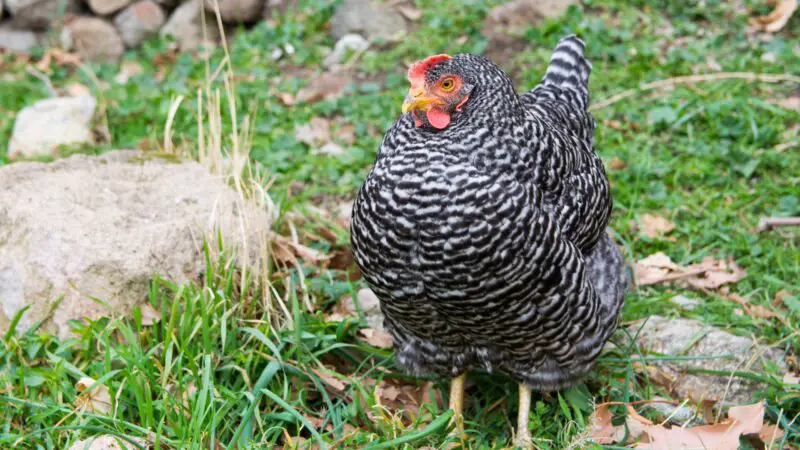
Place of Origin
Plymouth Rock chickens were first seen in Massachusetts sometime in 1829. They were developed by Dr. John C. Bennett in the 1840s but somehow lost their identity.
Fortunately, they were revived by D.A. Upham in the 1860s. These new Plymouth Rocks were created by crossing a Barred Rock male with a single comb and Black Java hens.
Appearance
Plymouth Rock chickens are known for having huge triangular-shaped bodies and long, broad backs. They also have pale red eyes, medium-sized red combs with five points, red round wattles, and oblong earlobes.
This American breed has a yellow beak, loose feathers all over their bodies, and unfeathered legs. There are four toes on each foot.
Color
Plymouth Rock chickens have eight color varieties, and all of them are recognized in the US. They are barred, black, blue, buff, Columbian, partridge, silver-penciled, and white.
The Barred Rock was the original Plymouth Rock chicken and has black and white bar feathers. This color variety and the White Plymouth Rocks are the most popular ones.
Height
There are no records showing the average height of Plymouth Rock chickens. Yet, they are among the tallest of the large chicken breeds.
Weight
Plymouth Rock chickens are a heavyweight breed. Roosters can weigh about 9.5 lbs (4.3 kilos), and hens weigh around 7.5 lbs (3.4 kilos). Bantam males can weigh up to 3 lbs (1.4 kilos), and bantam females are about 2.5 lbs (1.1 kilos).
Wingspan
There are no records about the wingspan of Plymouth Rock chickens.
Lifespan
If properly cared for, Plymouth Rock chickens can live between 10 and 12 years.
Characteristics
Plymouth Rock chickens are very sweet, docile, and calm birds. They are super friendly, love to be handled, and enjoy human attention, even from small children.
These curious chickens are not particularly noisy and are poor flyers. Their feathers grow fast, making them very cold and hardy. Plymouth Rocks also tolerate both confinement and free-ranging.
Purpose
Plymouth Rocks are dependable dual-purpose chickens. Hens lay an average of 200 large brown eggs per year, which are about 4 eggs weekly.
The Plymouth Rock chicken is also one of the most popular meat birds in the United States because its meat is juicy and tasty. This chicken breed can reach its mature weight at only 7 months old.
Related: Are Plymouth Rock Chickens Good Layers? | The Ultimate Guide
7. Cornish
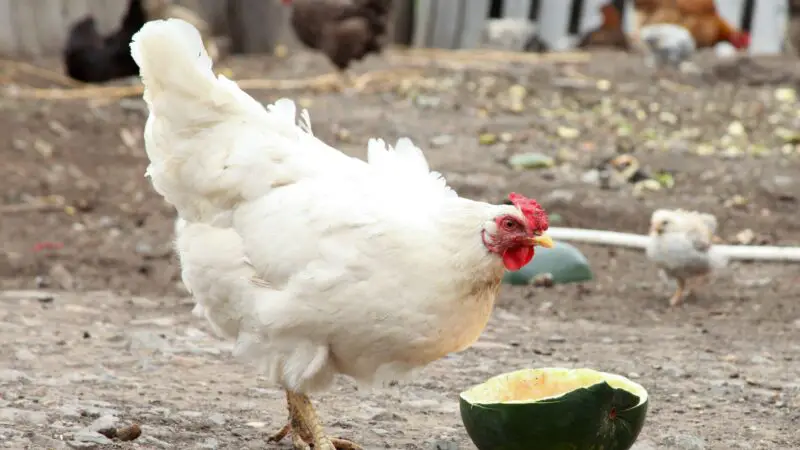
Place of Origin
The Cornish chicken was developed by Sir Walter Gilbert in Cornwall, England sometime in 1820. Its original name was Indian Game but was changed when the breed arrived in the US in the early part of the 20th century.
This breed should not be confused with the Cornish Game hen, a cross between Cornish and White Plymouth Rock chickens.
Appearance
Cornish chickens have pearl-colored eyes, pea-sized combs, small, red wattles, red earlobes, yellow beaks, and yellow, short thick legs without feathers.
They have muscular bodies, which are heart-shaped when viewed from above. These British chickens also have short and close feathers that make them look lighter than they are.
Color
There are several color varieties of Cornish chickens – Black, Buff, Dark, Double-Laced Blue, White, and White-Laced Red.
The Dark Cornish chicken was the first color variety to be admitted by the APA, followed by the others except for the black variety. Bantam versions also have the same color varieties, but Mottled and Spangled were later added.
Height
Although there are no records stating the height of Cornish chickens, they are very tall birds.
Weight
Cornish chickens are astonishingly heavy. Males weigh about 10.5 lbs (4.7 kilos), and females weigh about 8 lbs (3.6 kilos). Bantam males weigh about 4.4 lbs (2 kilos), while female bantams weigh about 3.3 lbs (1.5 kilos). On the other hand, Cornish Game hens have an average weight of 1.98 lbs (900 grams).
Wingspan
There are no records stating the wingspan of Cornish chickens.
Lifespan
Cornish chickens can live between 5 and 8 years, like other chicken breeds. On the other hand, the average lifespan of the Cornish Game hens is only 18 months. In fact, some of them have shorter lives due to health issues.
Characteristics
Cornish chickens are generally friendly, docile, and calm. But since they were originally bred as gamecock, some roosters can sometimes be aggressive towards humans and other breeds.
Nevertheless, they do well in both confinement and free range and don’t need a huge space. This breed can adapt to warmer climates but not in cold months.
Purpose
Cornish chickens are not a dual-purpose breed. They are very poor layers and can only have 50-100 light brown eggs, which is equivalent to 1 egg a week.
Nonetheless, their huge bodies are great for meat production. Cornish chicken meat also tastes great. And despite not having a very beautiful appearance, Cornish chickens are also exhibition birds.
8. Malines
Place of Origin
The Malines chicken was developed in Mechelen, Belgium in the 1800s by crossing local cuckoo-patterned farm chickens, including the Flemish Cuckoo with other large breeds, such as the Brahmas.
Locally known as Mechelse Koekoek, this Belgian chicken breed is also called Cuckoo Malines and should not be confused with Cuckoo Marans.
Appearance
Malines chickens have a single comb, tiny wattles, a short but thick neck, an upright body, and a sloping back. They also have bright red eyes, a white beak, short, well-tucked-up wings, and muscular, lightly feathered legs.
Each foot had four toes. A variant called Mechelse Kalkoenkop (turkey-headed Malines) has a very unusual triple comb.
Color
Malines chickens have several color varieties, which include black cuckoo and gold cuckoo. All of them are common only in Belgium, France, and Germany, and are very rare in the United States and elsewhere.
In fact, the Maline chicken is not recognized by the APA. Nevertheless, this breed is registered at the Poultry Club of Great Britain.
Height
There is no data about the height of Malines chickens, but they are considered a large breed.
Weight
Malines chickens are among the heaviest breeds around the world. Roosters can weigh up to a whopping 12 lbs (5.4 kilos), while hens weigh about 9 lbs. (4 kilos).
Wingspan
No records are revealing the wingspan of Malines chickens. But because they have short wings, their average wingspan is presumably small.
Lifespan
Malines chickens have an average lifespan of 6 years.
Characteristics
Not so much is written about the temperament of Malines chickens. Yet, they are said to be very friendly, docile, active, and excellent foragers, even during the summer.
This rare chicken breed can sometimes be noisy, especially the hens. Their short but thick feathers make them cold and hardy but may not help them do well during summer.
Purpose
Malines chickens are a dual-purpose breed. Hens typically lay 140-160 cream or light brown eggs a year or an average of 3 eggs per week.
Being a very heavy breed, they are excellent in meat production. Their carcasses consist of high-quality and tasty meat.
9. Malay
Place of Origin
The exact origin of the Malay chicken is quite a mystery. No one knows about their real ancestors, except that they were imported in 1830 to England from Asia, particularly India, Indonesia, and Malaysia.
A few years later, this ancient breed was seen across Europe and the United States. Unfortunately, their population today is considered critical.
Appearance
Malay chickens are famous for having notable long necks and legs. They also have pearly dark eyes, overhanging brows, short, yellow beaks, small wattles, a strawberry-shaped comb, long earlobes, and a fierce-looking face.
Their bodies are upright and sturdy, while their feathers are tight. In short, these birds look scary at a first glance.
Color
The original and most popular color variety of the Malay chicken is Black Breast Red, which was recognized by the American Standard of Perfection in 1883.
Other color varieties include Black, Red Pyle, Spangled, and White. All of them, including their bantam versions, were also admitted to the APA.
Height
The Malay chicken is dubbed the tallest chicken breed in the world. Malay roosters are 26 to 30 inches (2.1 to 2.5 feet) tall, but some can reach up to 3 feet tall. Hens are a bit shorter, though.
Weight
Aside from being among the biggest chicken breeds, Malay chickens are also among the heaviest. Roosters have an average weight of 9 lbs (4 kilos), while hens are about 7 lbs (3.2 kilos).
Bantam roosters weigh 2.6-3.0 lbs (1190–1360 grams), and bantam hens can weigh between 2.24 and 2.50 lbs (1020 and 1130 grams).
Wingspan
Malay chickens have a wingspan of 191–220 cm (75.2–86.6 inches).
Lifespan
Like other chicken breeds with no health issues, Malay chickens can live between 5 and 8 years.
Characteristics
Malay chickens are generally friendly but are not considered lap chickens. Although you can tame them while they are young, these towering chickens are very flighty and can unintentionally harm small children.
They can be aggressive to other chicken breeds due to their fighting instincts. Malay chickens can tolerate heat but don’t do well in the cold.
Purpose
Malay chickens are very poor egg layers since they can only lay 20-100 medium-sized brown eggs a year. This is equivalent to 1-2 eggs a week.
On the other hand, they are good in meat production, with a meat market weight of 5-7 lbs (2.2-3.2 kilos). Yet, Malay chickens are very useful today in crossing with other breeds and as ornamental birds.
10. Australorp
Place of Origin
As the name implies, the Australorp chicken originated in Australia. It was developed by crossing Langshans, Minorcas, Rhode Island Reds, White Leghorns, and Orpingtons in the early 1920s.
This Australian heritage chicken breed was recognized by the APA’s Standard of Perfection in 1929 and is Australia’s honorary national bird.
Appearance
Australorp chickens have featherless faces, a large, single comb, a dark beak, a deep, solid body, close-fitting, soft feathers, and a moderately long and broad back.
Their skin and feet bottoms are pinkish-white, while their wattles, combs, and earlobes are all red. Nevertheless, one of their unique, stunning features is their dark brown eyes.
Color
Australorp chickens have several color variants, depending on the location. The Australian Poultry Standards of Perfection recognized black, white, and blue, while the APA only recognized the original black version. Meanwhile, other color variants that are known in South Africa include the buff, golden, splash, and wheaten laced.
Height
Australorp chickens have an average height of 18 inches, but some strains can grow up to 27 inches tall.
Weight
Australorp chickens are a very heavy breed. Roosters have an average weight of 8.5 lbs (3.8 kilos), while hens weigh about 6.5 lbs (3 kilos). Bantam males weigh about 2.1-27 lbs (0.96-1.23 kilos), and bantam females weigh 1.74-2.29 lbs (0.79–1.04 kilos).
Wingspan
There are no records about the wingspan of Australorp chickens.
Lifespan
Australorp chickens can live between 6 and 10 years, and their average lifespan is 8 years.
Characteristics
Despite being heavyweight, Australorp chickens are very gentle, docile, and quiet. They are not aggressive and do exceptionally well with small children.
These huge birds are also not flighty and don’t bully smaller breeds. Australorps are adaptable to both free range and confinement. They are a very cold hardy breed but cannot tolerate too much heat.
Purpose
Australorp chickens are a dual-purpose breed and are excellent egg layers. If well taken care of, Australorp hens can lay 200-250 light-brown eggs a year.
From 1922 to 1923, they set world records for laying the most eggs per year. One of them has laid 364 eggs in 365 days! Yet, Australorps are also great in meat production.
11. Rhode Island Red
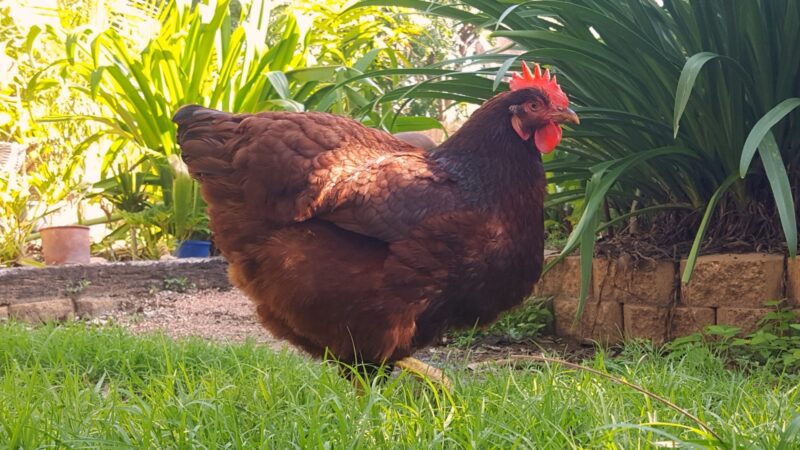
Place of Origin
The Rhode Island Red chicken was developed between the 1880s and early 1890s in Massachusetts and Rhode Island, hence the name.
It started when ship captain William Tripp crossed Malay chickens with his local chickens. This American chicken breed was further developed using Brown Leghorn Java, Plymouth Rocks, and Shanghai chickens.
Appearance
Rhode Island Red chickens have two comb varieties – the single-combed and the rose-combed. Both of them were admitted to the APA.
They have red-orange eyes, medium-size red combs, earlobes, wattles, and brick-shaped bodies. Their beaks, legs, and feet are all yellow. Each foot has four toes.
Color
Rhode Island Reds (RIRs) are generally red but range from deep pink to dark red. Some of them can be maroon with darker shades that look like black. Their chicks can be light red to tan. Interestingly, there are no other color variations.
Height
There are no records about the height of Rhode Island Reds, but they are reasonably tall.
Weight
Rhode Island Reds are a very heavy breed. Roosters weigh about 8.6 lbs (4 kilos), while hens weigh about 6.6 lbs (3 kilos). Bantam males weigh around 34.0 oz (960 grams), and bantam females weigh about 30 oz (850 grams).
Wingspan
There are no records about the wingspan of Rhode Island Reds.
Lifespan
Rhode Island Red chickens can live between 5 and 8 years, but some can live a bit longer.
Characteristics
Rhode Island Red chickens are generally friendly and docile, but some roosters can be pretty aggressive for no reason at all. Hence, small children should be guided properly if they want to touch this chicken.
Rhode Island Red chickens can be noisy at times, especially when hens are laying eggs. They can also adapt well during summer and winter, as well as rainy days.
Purpose
Rhode Island Red chickens are considered the best egg layers among the dual-purpose breeds. Their hens lay 200–300 brown eggs per year or 4-6 eggs a week!
They start laying eggs at 6 months old and can lay eggs continuously, even during winter. Not to mention, they are also great at producing rich-flavored meat, especially the “old type.”
12. New Hampshire Red
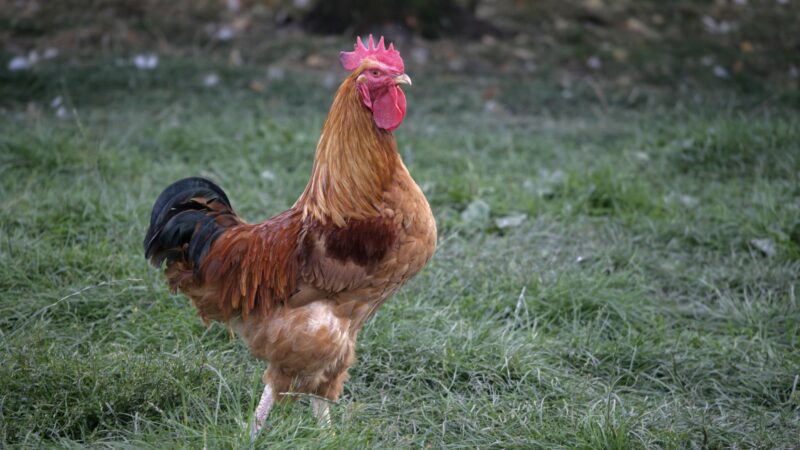
Place of Origin
The New Hampshire Red chicken was developed in the early 1900s in New Hampshire, USA, hence the name. It was created by Professor “Red” Richardson through the selective breeding of Rhode Island Reds.
This American breed is noted as one of the first breeds used in establishing the broiler industry and for creating the Delaware chicken breed.
Appearance
New Hampshire Reds look like the Rhode Island Red, except that they have a more triangular body shape. They have reddish-bay eyes, medium-size single combs, medium to large wattles, and elongated earlobes, along with a deep, broad body. Roosters have an upright comb, while the rear part of a hen’s comb flops to the side.
Color
Like the Rhode Island Reds, New Hampshire Reds also have red feathers. But instead of mahogany, the coloration is more chestnut with some pale yellow highlights.
Their feathers also bleach out to a lighter shade of red when hit by sunlight. There is also no other color variant.
Height
New Hampshire Red roosters can grow up to 17 inches (43 cm) tall, while hens are about 15 inches (38 cm) tall.
Weight
New Hampshire Red roosters are quite heavy. Males weigh about 8.5 lbs (3.8 kilos), and hens 6.5 lbs (3 kilos). Bantam roosters weigh about 35 oz (1 kilo), and bantam hens are about 26 oz (740 grams).
Wingspan
There are no records stating the wingspan of New Hampshire Red chickens.
Lifespan
New Hampshire Red chickens can live approximately 7 to 8 years.
Characteristics
New Hampshire Red chickens are moody. This means that they can be friendly and docile but can be pushy at any time, especially with other breeds. Roosters can also be aggressive towards small children.
Both sexes are fairly noisy and fit well in free-range or confinement. If properly taken care of, this breed can adapt to hot or cold weather.
Purpose
New Hampshire Red chickens are dual-purpose but are originally bred as meat birds. Most hens lay 150-200 large brown eggs a year or 3-4 eggs per week.
Nonetheless, this breed is usually bred more for meat production than egg production. Its meat has a market weight of 6.5-8.5 lbs. In some cases, it is also used in creating sex link chickens.
13. Delaware
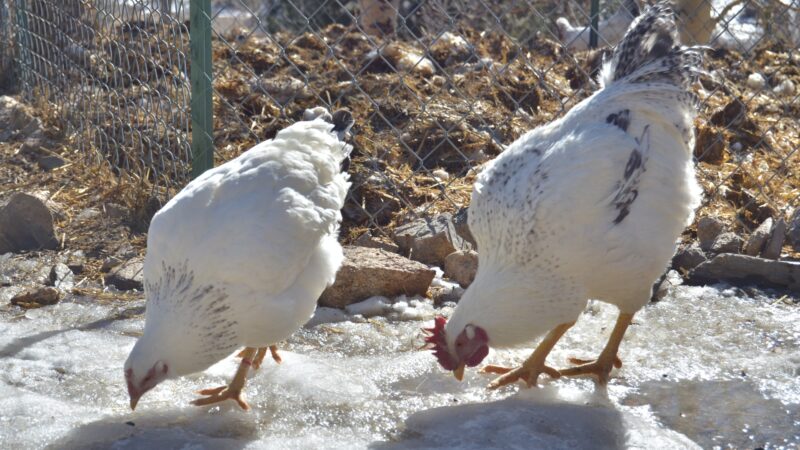
Place of Origin
The Delaware chicken was named after the state of Delaware, where it was developed by George Ellis in the 1940s.
Originally called the Indian River chicken, this fairly new chicken breed was created using Barred Plymouth Rock roosters and New Hampshire Red hens. This breed is now considered rare, but its population is gradually increasing.
Appearance
Delaware chickens have medium-sized heads, medium-sized single combs with five points, reddish beaks, and muscular yellow legs and feet. Their legs have no feathers, and each foot has four toes.
Their comb, ear lobes, and wattles are red, and their bodies are long and deep, forming an elegant U-shape when viewed from the side.
Color
Delaware chickens have only one color variety – white or silver with some black barring on the hackles and tail and sometimes on their bodies and wings. They were admitted to the APA in 1952.
In very few instances, some of them look like they have a Columbian color pattern. However, this pattern is barred in dark areas instead of a uniform color.
Height
There are no records showing the average height of Delaware chickens, but they are not as tall as other large chicken breeds.
Weight
Delaware roosters weigh about 8 lbs (3.8 kilos), and hens weigh around 6.5 lbs (2.9 kilos). Bantam roosters weigh about 35 oz (900 grams), and bantam hens are about 28 oz (790 grams).
Wingspan
There are no records stating the average wingspan of Delaware chickens.
Lifespan
Despite being able to mature faster than most heavy birds, Delaware chickens have a shorter lifespan. They can only live between 3 and 5 years. Only a few of them can live a bit longer.
Characteristics
Delaware chickens are generally calm and friendly, but they don’t want to be touched or cuddled. These American chickens are not aggressive but have forceful personalities.
They also tend to be noisy and curious but are not flighty. This cold hardy chicken breed prefers being free-range than in confinement and is not broody most of the time.
Purpose
Delaware chickens are a dual-purpose breed. Aside from being able to lay 200 large brown eggs a year (around 4 eggs/week), they are also great in meat production. But since their population is still not a lot, most of them are now used in poultry shows.
Related: Frizzle Chicken | Unexpected Wonders and Surprising Perks!
14. Langshan
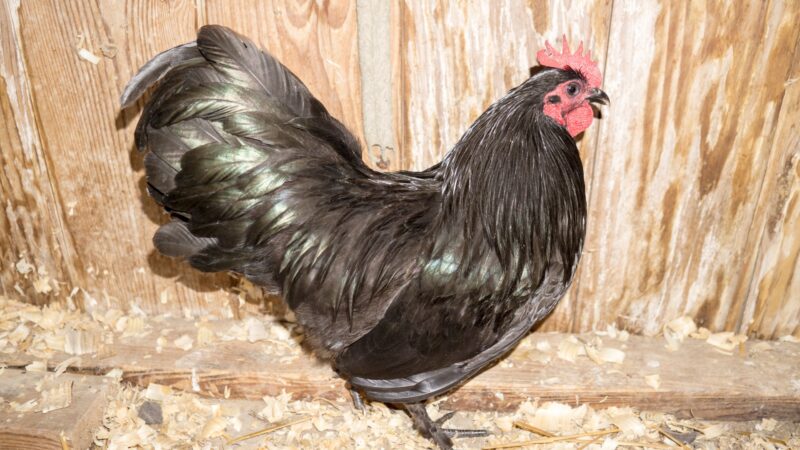
Place of Origin
The Langshan chicken was named after the Langshan Mountains (also called Wolf Hill), a scenic area in Jiangsu Province, China. Their ancestors remain unknown, though.
As one of the world’s oldest chicken breeds, it was first imported to England in 1872 by Major F.T. Croad. The Modern Langshan came from the original Croad Langshans.
Appearance
The Modern Langshan chicken looks like the Croad Langshans, except that they are a bit taller. Nonetheless, both types have medium-sized single combs, dark brown eyes, full, large breasts, tight feathers, a great depth of body, and fairly long legs. They have blue-black shanks and feet with some pink, and their skin and feet bottoms are white.
Color
Langshan chickens have three color varieties – black, white, and blue. All of them are recognized by the APA.
The blue variety is the result of crossing black Langshan and white Langshans. Some Langshans were bred in other colors or patterns, such as barred bantams, but they are not officially recognized in the United States.
Height
There are no records showing the average height of Langshan chickens, but their long legs make them look very tall.
Weight
Langshan chickens are a very heavy breed. Males have an average weight of 9.5 lbs (4.3. kilos), and females are around 7.5 lbs (3.4 kilos).
Wingspan
There are no records showing the average wingspan of Langshan chickens.
Lifespan
Langshan chickens are generally healthy and don’t have genetic issues. If well taken care of, they can live from 5 to 8 years.
Characteristics
Langshan chickens are calm, docile, and very friendly. They love to follow their master everywhere and even allow small children to touch and cuddle them.
Both sexes are not aggressive towards other breeds. Yet, they will stand their ground if other chickens bully them. Langshans are an incredibly hardy breed and can also tolerate moderate heat.
Purpose
Despite being slow starters, Langshan hens lay 150-220 large eggs a year or 3-4 eggs per week. They can also lay eggs continuously, even during winter. But contrary to an old myth, their eggs are deep brown, not purple.
Langshans are also great meat producers and have abundant breast meat. Their meat is tasty and has a market weight of 6.5-8 lbs.
Frequently Asked Questions
Will I Get Bigger Eggs From Bigger Birds?
You will get bigger eggs from bigger chicken breeds simply because their chicks are also big. Note, however, that pullets that lay eggs for the first time will produce small eggs, regardless of the breed.
As hens get older, their eggs will also get bigger until they reach their full size. The size of the hen’s uterus also affects the egg size.
Are Bigger Birds More Bad-Tempered Than Small Ones?
Bigger birds are not necessarily more bad-tempered than small ones. To start with, the temperament of a chicken is related to the breed and not to its size.
As you probably have noticed, not all the large chickens listed above are friendly and calm. Some of them are aggressive, as well as some small chicken breeds. But typically, egg-laying chickens are less aggressive than meat-producing ones.
Are Bigger Chicken Breeds More Likely to Escape?
Bigger chickens are not more likely to escape as compared to the smaller ones. In fact, almost all large breeds don’t fly high or frequently because they cannot lift their bodies enough.
This is also why you don’t need high fences if your chickens are big. But then, their weight can also be a problem since they cannot escape fast from predators.
Is It Harder to Raise Larger Chickens?
It is not necessarily harder or easier to raise larger chicken breeds. This is because there are some challenges to face that are not present when you are raising smaller chickens, and vice versa.
Although size matters a lot when it comes to chicken eggs and meat, this should not be the only factor when choosing the type of chicken to breed.
What Should You Consider in Raising Large Chicken Breeds?
Large chicken breeds have some advantages and disadvantages over smaller breeds. Although you can expect larger eggs and bigger meat, you cannot always enjoy both worlds.
In most cases, raising huge chickens also comes with a hefty investment. To help you out, here are some factors you should consider when raising larger chickens:
- Larger space – Whether you confine or allow them to free-range, large chicken breeds require a bigger space. Aside from having a larger coop, these chickens also need to exercise more to help avoid obesity.
- Pecking order – This hierarchy of chickens can be a problem for large chickens, regardless of their temperament. Avoid mixing them with different breeds, especially aggressive ones.
- Leg problems – Large chicken breeds are generally healthy, but their legs can get weak over time due to their weight. They are more prone to leg scratches and bumblefoot. You need to check their legs and feet regularly.
- Safe from predators – Not all large chickens can fight against predators, and some of them have no choice but to escape. But because of their heavy bodies, they tend to move slower. Having lots of roosting bars is a big help.
List of Sources
Production, Consumption Status and Economic Efficiency of Dong Tao Chicken Production
Choosing the Best Poultry Breed for Your Small Farm
